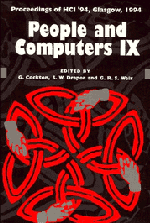Book contents
- Frontmatter
- Contents
- Preface: HCI'94 – You Probably Haven't Seen It All Before
- Part I Invited Papers
- Part II Methodology of Interactive Systems Development
- Crafting Interaction: Styles, Metaphors, Modalities and Agents
- 10 A Comparison of Placement Strategies for Effective Visual Design
- 11 Evaluation of Alternative Operations for Browsing Hypertext
- 12 On the Problem of Selecting Interaction Objects
- 13 Minimising Conceptual Baggage: Making Choices about Metaphor
- 14 Keeping an Eye on your Interface: The Potential for Eye-Based Control of Graphical User Interfaces (GUI's)
- 15 A Linguistic Approach to Sign Language Synthesis
- 16 Generalisation and the Adaptive Interface
- 17 Agent-Based Interaction
- Modelling Humans, Computers and their Interaction
- Notations and Tools for Design
- Part VI Computer-Supported Cooperative Work
- Author Index
- Keyword Index
17 - Agent-Based Interaction
Published online by Cambridge University Press: 04 August 2010
- Frontmatter
- Contents
- Preface: HCI'94 – You Probably Haven't Seen It All Before
- Part I Invited Papers
- Part II Methodology of Interactive Systems Development
- Crafting Interaction: Styles, Metaphors, Modalities and Agents
- 10 A Comparison of Placement Strategies for Effective Visual Design
- 11 Evaluation of Alternative Operations for Browsing Hypertext
- 12 On the Problem of Selecting Interaction Objects
- 13 Minimising Conceptual Baggage: Making Choices about Metaphor
- 14 Keeping an Eye on your Interface: The Potential for Eye-Based Control of Graphical User Interfaces (GUI's)
- 15 A Linguistic Approach to Sign Language Synthesis
- 16 Generalisation and the Adaptive Interface
- 17 Agent-Based Interaction
- Modelling Humans, Computers and their Interaction
- Notations and Tools for Design
- Part VI Computer-Supported Cooperative Work
- Author Index
- Keyword Index
Summary
Agents are becoming widespread in a variety of computer systems and domains, but often appear to have little in common with each other. In this paper we look at different agent systems and identify what a generic agent should be composed of. We also identify the characteristics of a task that make it worthy of an agentbased approach. We then discuss the implications for the interaction of using agents, that is, the notion of a balanced interface, and briefly look at how an agent-based approach assists in two very different application domains.
Keywords: agents, intelligent interfaces, groupwork, computer-supported cooperative work (CSCW).
Introduction
The term agent has become increasingly widespread over the past few years. Unfortunately, it has no consistent definition and means many different things to different people. This paper considers the multifarious uses that these disparate agents are put to and tries to identify what, if anything, they have in common. With this commonality in mind, we identify the general properties of an agent and consider what makes a task ‘agent worthy’.
Agent-based interaction has consequences, leading to the notion of a balanced interface. This leads on to a description of the design of a generic agent and a look at a couple of applications that are benefiting from being treated in an agent-based manner.
Classifying Agents
We can identify a number of categories that agents can be classified under, based on the functionality offered by the different types of agent.
- Type
- Chapter
- Information
- People and Computers , pp. 239 - 246Publisher: Cambridge University PressPrint publication year: 1994
- 11
- Cited by



